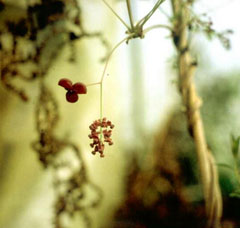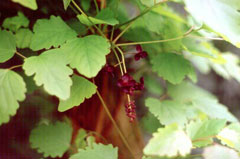 |
|
(c) ken Fern, Plants For A Future 2010 |
 |
| (c) ken Fern, Plants For A Future 2010 |
Translate this page:
Summary
Bloom Color: Purple, Red
Main Bloom Time: Early spring, Late spring, Mid spring. Form: Variable height, Variable spread.
Physical Characteristics

 Akebia trifoliata is a deciduous Climber growing to 9 m (29ft 6in) at a fast rate.
Akebia trifoliata is a deciduous Climber growing to 9 m (29ft 6in) at a fast rate.
See above for USDA hardiness. It is hardy to UK zone 5 and is not frost tender. It is in flower in April, and the seeds ripen from September to October. The species is monoecious (individual flowers are either male or female, but both sexes can be found on the same plant).
Suitable for: light (sandy), medium (loamy) and heavy (clay) soils and prefers well-drained soil. Suitable pH: mildly acid, neutral and basic (mildly alkaline) soils. It can grow in full shade (deep woodland) semi-shade (light woodland) or no shade. It prefers moist soil.
UK Hardiness Map
US Hardiness Map
Synonyms
Clematis trifoliata. A. lobata.
Plant Habitats
Woodland Garden Sunny Edge; Dappled Shade; Shady Edge; North Wall. By. East Wall. By. West Wall. By.
Edible Uses
Edible Parts: Fruit
Edible Uses: Tea
Fruit - raw. Sweet but insipid[2, 3, 46, 61, 105]. The fruit has a delicate flavour and a soft juicy texture[K]. The flavour can be enhanced by the addition of a little lemon juice. Valued more as a novelty, the fruit looks somewhat like a deep-purple coloured sausage[183]. The fruit is 7 - 13cm long[200]. The dried young leaves are used as a tea substitute[46, 61, 105, 183].
References More on Edible Uses
Medicinal Uses
Plants For A Future can not take any responsibility for any adverse effects from the use of plants. Always seek advice from a professional before using a plant medicinally.
Analgesic Antibacterial Antifungal Antiinflammatory Antitumor Blood tonic Cardiotonic Diuretic
Emmenagogue Galactogogue Urinary
The stems are analgesic, antibacterial, antifungal, anti-inflammatory, antitumor. blood tonic, cardiotonic, diuretic, emmenagogue and galactogogue[147, 176]. Taken internally, it controls gram-positive bacterial and fungal infections and is used in the treatment of urinary tract infections, lack of menstruation, to improve lactation etc[176, 238]. The stems are harvested in the autumn and dried for later use[238].
References More on Medicinal Uses
The Bookshop: Edible Plant Books
Our Latest books on Perennial Plants For Food Forests and Permaculture Gardens in paperback or digital formats.

Edible Tropical Plants
Food Forest Plants for Hotter Conditions: 250+ Plants For Tropical Food Forests & Permaculture Gardens.
More

Edible Temperate Plants
Plants for Your Food Forest: 500 Plants for Temperate Food Forests & Permaculture Gardens.
More

More Books
PFAF have eight books available in paperback and digital formats. Browse the shop for more information.
Shop Now
Other Uses
Basketry
The peeled stems are very pliable. They can be bleached and used in basket making[46, 61]. Landscape Uses: Arbor. The flowers are purple. The flowers have a sweet scent.
Special Uses
Food Forest Scented Plants
References More on Other Uses
Cultivation details
Requires a well-drained moisture-retentive loamy soil[11, 200]. Succeeds in acid or alkaline soils[200]. Prefers partial shade but succeeds in full sun[3, 200]. Grows well on a north facing wall[219]. Dormant plants are hardy to about -20°c but they can be somewhat tender when young[200]. Another report says that this species is not as hardy as A. quinata, only tolerating temperatures down to -10°c. The young growth in spring, even on mature plants, is frost-tender and so it is best to grow the plants in a position sheltered from the early morning sun[K]. This species grows very well in S.W. England. Resentful of root disturbance, either grow plants in containers prior to planting them out or plant them out whilst very young[219]. Plants are evergreen in mild winters[11]. Fast growing, it can be invasive. It grows well on deciduous trees[28]. Plants are not normally pruned, if they are growing too large they can be cut back by trimming them with shears in early spring[202]. Plants are shy to fruit, they possibly require some protection in the flowering season, hand pollination is advisable[3, 11]. Plants are probably self-sterile[182], if possible at least 2 plants should be grown, each from a different source. The flowers are sweetly scented[245]. The fruits are sold in local markets in Japan[46]. The ssp. A. trifoliata australis. (Diels.)Rehd. is used medicinally in China[176]. Plants in this genus are notably resistant to honey fungus[200]. Special Features:
Attractive foliage, Not North American native, Fragrant flowers, Attractive flowers or blooms.
References Carbon Farming Information and Carbon Sequestration Information
Temperature Converter
Type a value in the Celsius field to convert the value to Fahrenheit:
Fahrenheit:
The PFAF Bookshop
Plants For A Future have a number of books available in paperback and digital form. Book titles include Edible Plants, Edible Perennials, Edible Trees,Edible Shrubs, Woodland Gardening, and Temperate Food Forest Plants. Our new book is Food Forest Plants For Hotter Conditions (Tropical and Sub-Tropical).
Shop Now
Plant Propagation
Seed - best sown in a cold frame as soon as it is ripe. Surface sow in a light position[133]. The seed usually germinates in 1 - 3 months at 15°c[133]. Stored seed should be given 1 month cold stratification[113, 133] and can be very difficult to germinate. When large enough to handle, prick the seedlings out into individual pots and grow them on in light shade in the greenhouse for at least their first winter. Plant out in late spring or early summer, after the last expected frosts. Cuttings of half-ripe wood, July/August in a frame[11, 113]. The cuttings can be slow to root[200]. Cuttings can also be taken of soft wood in spring[113]. Root cuttings, December in a warm greenhouse[113]. Layering in early spring[1]. Very easy, the plants usually self-layer and so all you need to do is dig up the new plants and plant them out directly into their permanent positions.
Other Names
If available other names are mentioned here
Bayuegua, Bayuezha, Mitsuba-akebi, Three Leaf Akebia [1-4].
Native Range
TEMPERATE ASIA: Anhui Sheng, Fujian Sheng, Gansu Sheng (southeast), Guangdong Sheng, Guizhou Sheng, Henan Sheng, Hokkaidô, Honshu, Hubei Sheng, Hunan Sheng, Japan, Jiangsu Sheng, Jiangxi Sheng, Kyushu, Shaanxi Sheng (south), Shandong Sheng, Shanxi Sheng (south), Shikoku, Sichuan Sheng, Taiwan, Yunnan Sheng, Zhejiang Sheng,China.
Weed Potential
Right plant wrong place. We are currently updating this section.
Please note that a plant may be invasive in one area but may not in your area so it's worth checking.
Conservation Status
IUCN Red List of Threatened Plants Status :

Growth: S = slow M = medium F = fast. Soil: L = light (sandy) M = medium H = heavy (clay). pH: A = acid N = neutral B = basic (alkaline). Shade: F = full shade S = semi-shade N = no shade. Moisture: D = dry M = Moist We = wet Wa = water.
Now available:
Food Forest Plants for Mediterranean Conditions
350+ Perennial Plants For Mediterranean and Drier Food Forests and Permaculture Gardens.
[Paperback and eBook]
This is the third in Plants For A Future's series of plant guides for food forests tailored to
specific climate zones. Following volumes on temperate and tropical ecosystems, this book focuses
on species suited to Mediterranean conditions—regions with hot, dry summers and cool, wet winters,
often facing the added challenge of climate change.
Read More
Expert comment
Author
(Thunb.)Koidz.
Botanical References
1158200
Links / References
For a list of references used on this page please go here
Readers comment
© 2010, Plants For A Future. Plants For A Future is a charitable company limited by guarantee, registered in England and Wales. Charity No. 1057719, Company No. 3204567.